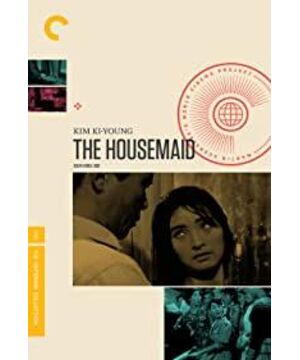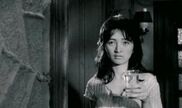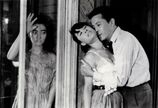By Bong Joon Ho & Martin Scorsese & Tony Raynes
Translator: csh & dreamingkids
Source: Sight & Sound
The translation was first published on the public account of the "Literature Department of Beijing Film Academy"
1. "Jin Qiyong is a real master" (Bong Joon-ho)
"Parasite" benefits in large part from Jin Qiyong's "Secret Girl," a 1960 work that astonishingly explores issues of class and desire. In this interview, Bong Joon-ho talks about the origins of his discovery of the work, which is now widely regarded as the greatest film in Korean cinema history.
Jin Qiyong's 1960 film "Lady" is a work that has a deep influence on "Parasite". The film focuses on a middle-class family whose members aspire to be upper-class. When a maid (lower daughter) comes to the family, we see the fear they face.
I discovered this film by Jin Qiyong in the 1990s. In the late 1980s, after the end of the Korean military rule, the official film archive was established. Before the military rule in the 1980s, there was no formal film archive), so it was possible to rewatch some old movies. During this period, the Korean movie fan culture also began to rise, and Jin Qiyong appeared in the audience's field of vision again, and was considered to be a very important figure in the Korean film industry. In 1997, the Busan Film Festival held a retrospective of his film, which not only attracted international critics, but also attracted the attention of many local Korean fans. I became a big fan of Jin Qiyong. I was still an assistant director at the time. I still remember running around the video store trying to find his rare films.
The news that Jin Qiyong died at home in 1998 was shocking. But even his death was as dramatic as the plot of the movie—although it might sound a little unsympathetic to say that.
After his death, people gradually found something interesting in his films. He had a retrospective at the Berlin film festival in 1998, and in 2006 at the Cinématheque française in Paris, where I was a curator. From the late 1990s until the early 2000s, Kim Ki-young established her own immortal status in the Korean film industry.
He left Korean filmmakers with a wealth of innumerable riches, including a creative visual style, and a unique, raw urge—an urgent need to portray human desires. Also worth mentioning is his bizarre approach to cinematic space. All these deeply shocked me, and I was especially surprised that he was able to create so many works during the military rule period. Of course, there are filmmakers in other countries who are very similar to Jin Qiyong, such as Luis Buñuel and Imamura Shohei, who are masters of using films to deal with desire. I used to watch their films voraciously, but then, to my great surprise, there is such a film director in Korea.
Jin Qiyong's Burial of Goryeo (1963) is very similar to Shohei Imamura's "Narayama Festival Kao" (1983), and they both describe the same customs. Jin Qiyong and Imamura Shohei are very similar in dealing with human desires and female roles. The women in Jin Qiyong's films are not the stereotyped image that is hurt by love. They often appear stronger than men. For example, the maid in "The Next Girl" is a powerful, working-class character. . And the male characters in Jin Qiyong's films are pathetic, contrived and stupid. You can also find this in my films because I was influenced by Jin Qiyong. I think the way he portrays the male characters has a lot to do with his own life experiences.
Every ten years, Sight & Sound magazine votes for its own best film of all time. In 2012, the number one spot on the list changed from Citizen Kane (1941) to Vertigo (1958). A very similar situation occurred in South Korea. For a long time, the No. 1 film has been Misfired (1960), a social realist film directed by master director Yu Hyun-mu. However, when Jin Qiyong's retrospective screening ended, the list changed, and "The Girl" became the number one movie.
The Korean Film Archive is now restoring Kim Ki-young's films and releasing them on Blu-ray. I would like to be like Arrow films (British independent film distributor, mainly distributing cult films, art films, horror films and classic films), Indicator films (Indicator films, British package media distribution company, the company is "Powerhouse Films" In the name of "indicator movies" when releasing classic movies), Criterion or the British National Film Institute (BFI), etc., can release Jin Qiyong's Blu-ray set collection. I often recommend Jin Qiyong to the filmmakers I meet, he is a true master.
2. Martin Scorsese on "The Second Lady"
"Lady" is a compelling film, and I can totally say it's unlike anything I've seen before. After watching the film for the first time, I was struck by its repressed emotions, its bold expressionism, and the potential dangers of all human interactions. The tense and violent emotions in the film bring a sense of psychological claustrophobia. I don't think it's an easy movie, in fact, it's a deeply meaningful and memorable movie. Therefore, it is not difficult to understand that it has had a profound and long-lasting influence on a large number of Korean filmmakers, including Park Chan-wook, Lim Sang-soo and Bong Joon-ho. In the West, Jin Qiyong's films have become better known and easier to see. I hope this trend will continue. (Year 2014)
3. The Weirdness of Jin Qiyong (Tony Rains)
When the period of Korean military rule passed in the 1990s, Koreans rediscovered Jin Qiyong's works, and Feng Junhao has long admired him, all of which have made Jin Qiyong one of the recognized masters of Korean film today. So, how can the unrestrained absurdity and animalistic expression in this director's work have such a powerful appeal? Below, Tony Rayns explains it to us.
In his heyday, Jin Qiyong (1919-1998) was a perfect paradox: he was both in the current and the countercurrent of the times. His active period began in the mid-1950s and continued until the late 1970s. South Korea's film industry also struggled with censorship and policy from the military government in the wake of the Korean War. He has won many awards and made many box office hits, but he still keeps his distance from the mainstream film industry. On the one hand, he will respond to social events in the film, on the other hand, he is also holding on to his fascination with the eccentric, alternative world. These films are filled with frail men whose desires undo their masculinity. Also, we can see some powerful women who go crazy when their tricks don't work. Therefore, we can call Jin Qiyong a maverick. Those ugly, bizarre horror movies were always to his taste. Newspapers in South Korea have always criticized his films for their over-expression—and the British press did the same with Michael Powell's Peeping Tom in 1960.
In 1988, I came to Seoul for the first time, which brought me into contact with Jin Qiyong's works for the first time. A friend took me to the Korean Film Archive (an executive branch of a dying military government), and we saw Kim Qi-young's nightmarish fantasy, "The Second Girl." Shortly after that, Bong Joon Ho gave me a subtitled home video of Jin Qiyong's "Fire Girl" (1971) as a thank you gift because I gave him his Added subtitles to Film Academy graduation productions. I realized that "Fire Girl" turned out to be a color-upgraded version of "Lower Girl". So, in 1997, when the second Busan Film Festival restored and screened many of Kim Ki-young's films to reinvent the history of Korean film, I already realized that something was going to happen. However, no one can predict the final result. At that year's festival, many of the independent filmmakers present — as well as a handful of foreign guests — thought Jin Qiyong was a master. A French film promoter asked Jin Qiyong if he saw himself as a surrealist artist. Film archives around the world have strongly requested a retrospective of Jin Qiyong.
Sadly, Jin Qiyong and his wife died in a family fire just months after the festival. Therefore, the Korean Film Archive (KFA) took the baton. When South Korea switched to a civilian government in 1993, the KFA began to develop into an active, capable organization. It first released DVDs of Jin Qiyong's five pre-existing films, based on a series of previously released copies that were riddled with scratches and smears. Next, Martin Scorsese's World Cinema Foundation stepped in to restore The Second Lady (in the process, crews needed to digitally erase the ugly original subtitles) ), the speed of hooking and sinking Jin Qiyong's works has become faster. In 2019, KFA released high-quality, Blu-ray versions of The Burial of Goryeo (1963, adapted by Jin Qiyong, a remake of Keisuke Kinoshita's "Narayama Festival Kao" [1958]) and "Island of Fish" (1977). , the set contains a facsimile of the original script, which Jin Qiyong had originally envisioned in English as "Blue Fish Island"), which is a highly skilled work. Next, we will see more works, two extraordinary works should be given priority, they are "Insect Girl" (1973, which seems to be inspired by Imamura's film of the same name "Insects of Japan" [1963 , Translator's Note: The English titles of the two films are "The Insect Woman"], but these are two completely different works) and "Bound in the Body" (1975).
Many of Jin Qiyong's works have been lost, but it is clear that his career is divided into three stages. After studying medicine and working in theater, he began his film career with the United States Information Service during the Korean War. His earliest surviving film is the unsigned short film "I Am a Truck" (1952, which can be seen in the accompanying video of the Blu-ray version of "Goryeo's Burial"), a poetic documentary that presents The process of recycling metal parts. This work is comparable to any Western wartime film we have in mind. Kim Ki-young's earliest surviving feature film is his second feature, Yangsando (1955), a traditional sentimental melodrama set in the late Joseon Dynasty. In this work, a village chief has a spoiled son who tries to snatch the young woman he is engaged to from a peasant. Jin Qiyong has almost completely wiped out the sentimental content. Instead, he has raised the cruelty and abuse by a grade or two, and emphasized the filth and despicability of rural life. From these films, we can realize that in the first stage of Jin Qiyong's creative career, he has instinctively mastered the orthodox film language, but he is slightly deviant.
Jin Qiyong's second stage (that is, his greatest stage) began in 1960's "Lady", and this stage lasted for a full seventeen years. It can be seen from these films that Jin Qiyong prefers stylized plots and visual effects compared to "realism". In addition, he will interpret the abnormal state of human beings through escalating, hysterical stories. "Lady" lays the foundation for this model: a married man who teaches music to factory workers, hires a country woman as a maid—who possesses a fatal attraction—and eventually impregnates her . She fell down the stairs on purpose, which resulted in her miscarriage (a two-story house seemed a novelty at the time, and a status symbol). But then she began torturing him in front of his wife (a home tailor), daughter (a polio survivor) and young son. Using mise-en-scene, Jin Qiyong skillfully places the characters' movements in enclosed spaces and uses recurring imagery (sliding doors, sewing machine pedals, high or low angles, rat poison) to create a hysterical atmosphere, which ultimately pushes the film to that pivotal passage that rivals Pasolini's Porcile (1969). Jin Qiyong likes this plot so much that he uses it repeatedly in his own works, including "Fire Girl" and his own remake of "Fire Girl (82 Edition)" (1982).
Two other very prominent works in this phase are "Koryo Burial" and "Island of Fish", which KFA also recently restored and released on Blu-ray. When making "The Burial of Goryeo", Jin Qiyong hadn't seen Keisuke Kinoshita's "Narayama Festival Exam", because until the late 1990s, Japanese movies were banned in South Korea, and he probably just read the already Published screenplay. In his version of the legend (when the villagers reached the age of seventy, they were carried up the hill to "make way" for the next generation), he replaced the original song and dance with a belief system rooted in shamanic prophecy He also added content about village vendettas and ten-man gangs. This highly stylized, studio-shot film is more brutal and shocking than Kinoshita's version. In "Island of Different Fish", Jin Qiyong adapted Li Qingjun's Korean novel into a shamanic prophecy. The work tells the story of a legendary island near Jeju that is populated by female divers. Jin Qiyong added content to protest against environmental pollution. Both films can be seen as a manifesto for Jin Qiyong, who will do anything to spread his bizarre ideas about racial reproduction. The Blu-ray version of "Isle of Fishes" retains those passages that were cut by censors in 1977, not least of which is the shocking climax. In that scene, the shaman resurrects a man who has drowned in the sea, and we see his soft cock stiffen and be able to perform sexual intercourse after death. In the final stages of Kim's career, he struggled to produce works with extremely low budgets and short production times to meet the government's mandatory quota for Korean films, which involved importing high-margin foreign films. that power. He dismissed most of the films at this stage, but it did include a number of fan-favorites, including Girl Chasing a Killer Butterfly (1978) and a group of Mario Bava A trilogy, the latter of which tells the story of a student haunted by ghosts who are menacing and/or lustful. Jin Qiyong continues his eccentricities, but his work has lost that deep seriousness. Bong Joon-ho has been advocating Jin Qiyong's work for which he recorded commentary tracks on three KFA discs. Now, the discs are trying to show audiences outside Korea what has been forgotten.
View more about The Housemaid reviews






